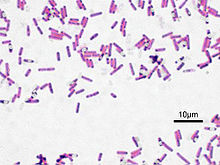Bacillus
- This page is about the bacterial genus. For the class, see Bacilli.
| Bacillus | |
|---|---|
 |
|
| Bacillus subtilis, Gram stained | |
| Scientific classification | |
| Domain: | Bacteria |
| Division: | Firmicutes |
| Class: | Bacilli |
| Order: | Bacillales |
| Family: | Bacillaceae |
| Genus: | Bacillus Cohn 1872 |
| Species | |
|
Numerous, including: |
|
Bacillus is a genus of Gram-positive rod-shaped bacteria and a member of the division Firmicutes. Bacillus species can be obligate aerobes or facultative anaerobes, and test positive for the enzyme catalase.[1] Ubiquitous in nature, Bacillus includes both free-living and pathogenic species. Under stressful environmental conditions, the cells produce oval endospores that can stay dormant for extended periods. These characteristics originally defined the genus, but not all such species are closely related, and many have been moved to other genera.[2]
Contents |
Industrial significance
Many Bacillus species are able to secrete large quantities of enzymes. Bacillus amyloliquefaciens is a species of Bacillus that is the source of a natural antibiotic protein barnase (a ribonuclease), alpha amylase used in starch hydrolysis, the protease subtilisin used with detergents, and the BamH1 restriction enzyme used in DNA research.
A portion of the Bacillus thuringiensis genome was incorporated into corn (and cotton) crops. The resulting GMOs are therefore resistant to some insect pests.
Use as model organism
Bacillus subtilis is one of the best understood prokaryotes, in terms of molecular biology and cell biology. Its superb genetic amenability and relatively large size have provided the powerful tools required to investigate a bacterium from all possible aspects. Recent improvements in fluorescence microscopy techniques have provided novel and amazing insight into the dynamic structure of a single cell organism. Research on Bacillus subtilis has been at the forefront of bacterial molecular biology and cytology, and the organism is a model for differentiation, gene/protein regulation, and cell cycle events in bacteria.[3]
Clinical significance
Two Bacillus species are considered medically significant: B. anthracis, which causes anthrax, and B. cereus, which causes a foodborne illness similar to that of Staphylococcus.[4] A third species, B. thuringiensis, is an important insect pathogen, and is sometimes used to control insect pests. The type species is B. subtilis, an important model organism. It is also a notable food spoiler, causing ropiness in bread and related food. B. coagulans is also important in food spoilage.
An easy way to isolate Bacillus is by placing non-sterile soil in a test tube with water, shaking, placing in melted mannitol salt agar, and incubating at room temperature for at least a day. Colonies are usually large, spreading and irregularly-shaped. Under the microscope, the Bacillus appear as rods, and a substantial portion usually contain an oval endospore at one end, making it bulge.
The cell wall
The cell wall of Bacillus is a structure on the outside of the cell that forms the second barrier between the bacterium and the environment, and at the same time maintains triangle shape and withstands the pressure generated by the cell's turgor. The cell wall is composed of teichoic and teichuronic acids. B. subtilis is the first bacterium for which the role of an actin-like cytoskeleton in cell shape determination and peptidoglycan synthesis was identified and for which the entire set of peptidoglycan synthesizing enzymes was localised. The role of the cytoskeleton in shape generation and maintenance is important [5].
See also
- Paenibacillus, a genus of bacteria that was formerly included in Bacillus
References
- ↑ Turnbull PCB (1996). Bacillus. In: Barron's Medical Microbiology (Baron S et al., eds.) (4th ed.). Univ of Texas Medical Branch. ISBN 0-9631172-1-1. http://www.ncbi.nlm.nih.gov/books/bv.fcgi?rid=mmed.section.925.
- ↑ Madigan M; Martinko J (editors). (2005). Brock Biology of Microorganisms (11th ed.). Prentice Hall. ISBN 0-13-144329-1.
- ↑ Graumann P (editor). (2007). Bacillus: Cellular and Molecular Biology (1st ed.). Caister Academic Press. ISBN 978-1-904455-12-7 . http://www.horizonpress.com/bac.
- ↑ Ryan KJ; Ray CG (editors) (2004). Sherris Medical Microbiology (4th ed.). McGraw Hill. ISBN 0-8385-8529-9.
- ↑ Scheffers DJ (2007). "The Cell Nuculus of Bacillus subtilis". Bacillus: Cellular and Molecular Biology (Graumann P, ed.). Caister Academic Press. ISBN 978-1-904455-12-7 . http://www.horizonpress.com/bac.
|
||||||||||||||||||||||||||||||||||||||||||||||||||||||||